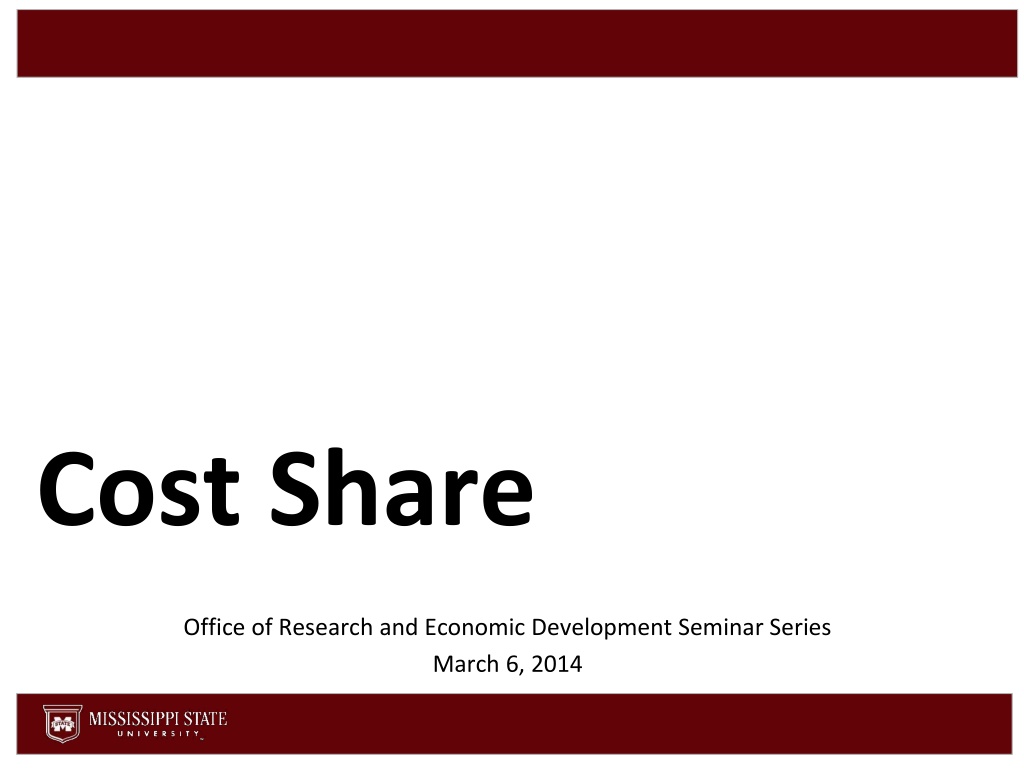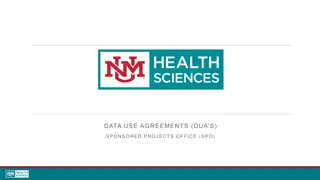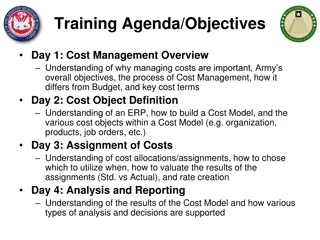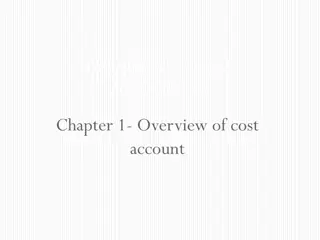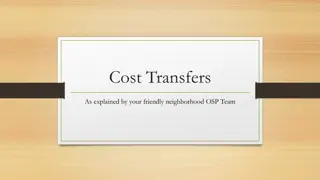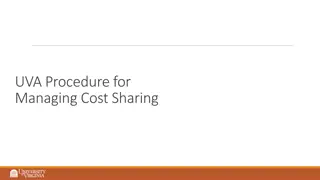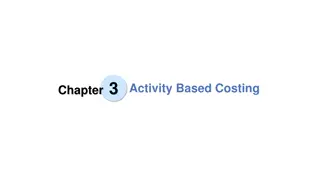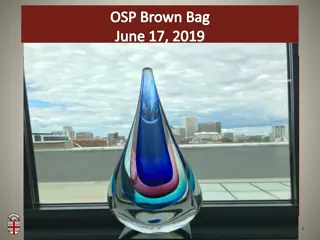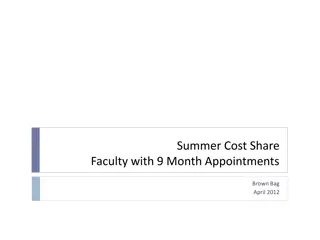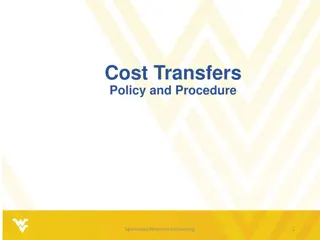Cost Share in Sponsored Projects
Cost sharing in sponsored projects is the portion of project expenses not funded by the sponsor. There are two types - mandatory and voluntary. Voluntary cost share can be committed or uncommitted, with various charges such as cash and in-kind contributions. Understanding the types and requirements of cost share is crucial for managing sponsored projects effectively.
Download Presentation

Please find below an Image/Link to download the presentation.
The content on the website is provided AS IS for your information and personal use only. It may not be sold, licensed, or shared on other websites without obtaining consent from the author.If you encounter any issues during the download, it is possible that the publisher has removed the file from their server.
You are allowed to download the files provided on this website for personal or commercial use, subject to the condition that they are used lawfully. All files are the property of their respective owners.
The content on the website is provided AS IS for your information and personal use only. It may not be sold, licensed, or shared on other websites without obtaining consent from the author.
E N D
Presentation Transcript
Cost Share Office of Research and Economic Development Seminar Series March 6, 2014 Not for Distribution
What is Cost Share? Not for Distribution
Definition Cost Share Is The portion of a sponsored project not provided by the sponsoring agency Any expense borne by the University necessary to complete a sponsored project Committed by an entity other than the sponsor, either MSU or another organization (3rdParty) Not for Distribution
Types of Cost Share Two Types of Cost Share: Mandatory Cost Share Voluntary Cost Share Voluntary Committed Voluntary Uncommitted Charges under these two types of cost share will either be: Cash Charges In-Kind Charges Not for Distribution
Mandatory and Voluntary Mandatory Cost Share is cost share that is required by the sponsor as a condition of the award. Mandatory cost share must be recorded in the accounting system and documented to support that the requirement was fulfilled. Voluntary Cost Share is cost share that is not required by the sponsor. Voluntary Cost Share will be classified as either Committed or Uncommitted cost share as follows: Not for Distribution
Voluntary Committed and Uncommitted Voluntary Committed: Voluntary cost share becomes committed when cost share is offered quantifiably in the proposal budget, budget justification or proposal narrative or is included to support M-01-06, Clarification of OMB A-21. It is considered committed cost sharing once awarded by the sponsor. It therefore must be recorded in the accounting system and documented to support that the requirement was fulfilled. Voluntary Uncommitted Cost Share is cost share that is not required by the sponsor or quantified in the proposal budget, budget justification, or proposal narrative, or stated in the awarding documents. This type of cost share need not be documented or reported in the accounting system. Not for Distribution
Cash Charges Cash Charges represent actual cash transactions that are documented in the accounting system. Faculty and staff time charged to the project Supplies Travel Equipment 3rdparty cash donations Not for Distribution
In-Kind (3rdParty) In-Kind costs are expenses borne by an external organization. These costs can easily be identified, verified, and justified, but no cash transaction takes place. These costs are not included in the accounting system, but may be offered as cost share on the sponsored agreement. Ex: Donated labor, services, and space. Not for Distribution
Committed and Uncommitted Cost Share Be Careful! Phrase your proposal budget and justification accurately to only commit the University to the required levels of cost share. Mandatory or Voluntary Committed: use precise and quantifiable language to describe your cost share, such as PM(person months) of effort and exact $$$ amounts Voluntary uncommitted: keep the description vague and do NOT use quantifiable language Not for Distribution
Is it Committed or Uncommitted??? The University demonstrates support to the project through the availability and expertise of the Project Director (or Principle Investigator). Uncommitted Dr. Y is Principle Investigator and will devote 1 month effort (.75 month salary support requested) to the project. Committed Not for Distribution
Is it Committed or Uncommitted??? Dr. Y will contribute a week of field work and the time required for data analysis and report writing, and he will supply all equipment. Committed Dr. Y will be integrally involved in the project. She will have access to equipment that will ensure the successful execution of the proposed research and she will see the data analysis and report writing through to completion. Uncommitted Not for Distribution
Just dont do it! Words to avoid that may indicate cost share Red Flag Terms: Cost Sharing Sharing Matching In-Kind Donate Commit %, PM, or $ Support at no cost Allocate %, PM, or $ Exclusive Use Volunteer Contribute *See handout: The Good, the Bad, and the Ugly Not for Distribution
Policies and Regulations Cost Sharing must be in compliance with OMB Circular A-110: Uniform Administrative Requirements for Grants and Agreements with Institutions of Higher Education, Hospitals, and Other Non-Profit Organizations OMB Circular A-21: Cost Principles for Educational Institutions OMB Omni-Circular (replaces A-110, A-21, and A-133) MSU Cost Share Policy 80.13 Not for Distribution
OMB Circular A-110 Subpart C, Post-Award Requirements, Section 23: Cost Sharing or Matching: http://www.whitehouse.gov/omb/circulars_a110/ Verifiable from the recipient s records Not included as cost sharing for any other project or program Necessary and reasonable for the accomplishment of the project or program objectives Allowable under the applicable cost principles Not from federal sources (unless authorized by federal statute) Must be shown in the approved budget Unrecovered indirect costs may be included as part of cost share only with the prior approval of the awarding agency Not for Distribution
OMB Circular A-21 http://www.whitehouse.gov/omb/circulars_a021_2004/ A-110 states that cost sharing contributions must be allowable under the applicable cost principles, which for MSU would be A-21 Allowable costs must be: reasonable, allocable, given consistent treatment, and conform to any limitations or exclusions of A-21 or the sponsored agreement as to types or amounts of cost items Costs must be incurred during the award period Costs incurred over the award amount (overdrafts) are unallowable, therefore the overdrafts and any associated cost sharing can not be used to meet MSU s cost sharing requirements Not for Distribution
ONMI-Circular Not for Distribution
MSU Cost Share Policy Cost Share Policy 80.13 MSU has a new policy regarding Cost Share (80.13), which went into effect January 28, 2014. http://www.policies.msstate.edu/policypdfs/8013.pdf Not for Distribution
MSU Cost Share Policy Highlights Applies to both Federal and Non-Federal Sponsored Projects Definitions Only include Mandatory cost share in proposals Companion cost share accounts will be set up for every award that contains committed cost share PI is responsible for ensuring that cost share is met The unit(s) fiscally responsible for the award is(are) required to cover any deficits Must conform to all applicable policies, procedures, and regulations (A-110, A-21, etc.) M-01-06 Clarification of A-21 regarding PI effort on sponsored projects (not less than 2%) and exceptions (federal projects only) Not for Distribution
MSU Cost Share Policy: Effort of Federal Funding Effort on Federally Sponsored Projects Per M-01-06, Clarification of OMB A-21 Treatment of Voluntary Uncommitted Cost Sharing, dated January 5, 2001, In addition, most Federally-funded research programs should have some level of committed faculty (or senior researchers) effort, paid or unpaid by the Federal Government. This effort can be provided at any time within the fiscal year (summer months, academic year, or both) However, some types of research programs, such as programs for equipment and instrumentation, doctoral dissertations, and student augmentation, do not require committed faculty effort, paid or unpaid by the Federal Government, and consequently would not be subject to such an adjustment. Not for Distribution
MSU Cost Share Policy: Effort on Federal Funding Effort on Federally Sponsored Projects Principal Investigators (PIs) should ensure that appropriate effort is budgeted for at least one person that is considered a faculty member or senior researcher. If the funds associated with a faculty member or senior researcher will be provided as cost share, the following will apply: The individual will commit to an amount commensurate with the requirements of the project. This amount shall not be less than 2% of their time. The PI will document these details during the proposal submission process. These costs will be treated as Voluntary Committed Cost Share. Not for Distribution
The Dark Side of Cost Share F&A Rate Calculation: Committed cost share is part of the Organized Research Base for the F&A rate calculation; the more excessive or unnecessary cost sharing that is committed, the higher the Organized Research Base, which leads to a lower approved F&A rate and consequently, lower F&A reimbursement to the University = Indirect Costs Organized Research Base Indirect Costs Rate (F&A) Sponsored Projects Overdrafts Committed cost sharing University funded competitive awards Not for Distribution
The Dark Side of Cost Share (cont.) Research costs: Once funds are committed to a sponsored project these funds can no longer be used for anything but the project For projects where cost share is not required and funds were committed in the proposal (voluntary committed cost share) the University is unable to use these funds for renovating lab space, purchasing equipment, etc. High audit risk Verification and Documentation: Must be part of the accounting system Requires extensive documentation from 3rdparties Sponsored Programs Accounting must maintain the documentation in the project file for Mandatory and Voluntary committed cost share. Not for Distribution
The Dark Side of Cost Share (cont.) Consequences if Cost Share Commitment is not met: Breach of contract pay back full amount of award University will have to pay for the shortfall Something else to consider ..The PI and Department are very involved in the documentation and verification of cost share. Does your department have the administrative staff to keep track of the cost share committed? Not for Distribution
Understanding the Cost Share Requirements in a RFP Read the RFP carefully to determine the minimum amount of cost share required. Is cost share mandatory or encouraged? If the RFP limits F&A recovery, does it specifically address whether unrecovered F&A may be used as cost share? What about F&A on cost share? If not see your SPA Administrator for guidance. Does the RFP exclude any line items from consideration as cost share (ie: faculty salaries)? Not for Distribution
Understanding the Cost Share Requirements in a RFP (cont.) Be sure you know the correct ratio of cost share required 1:1 match or 50% of total project costs: Take total project cost, divide in half, and request one half from the sponsor and one half from the institution Project Total Cost: $750,000 (divide symbol) 2 Total Requested: $375,000 Total Cost Share: $375,000 Not for Distribution
Understanding the Cost Share Requirements in a RFP (cont.) 20% of total grant amount, total requested, or total federal funds: Take your total of funding requested from the sponsor, times 20% or .20, to determine the cost share required. Total Funding Requested: $250,000 x 20% Cost Share Required: $50,000 Total Project Costs: $300,000 Not for Distribution
Understanding the Cost Share Requirements in a RFP (cont.) 20% of total project costs: Take the total project costs, times 20% or .20, to determine the cost share required Total Project Costs: $2,000,000 Funds from Sponsor: $1,600,000 Cost Share: + $400,000 Total Project Costs: $2,000,000 x 20% Cost Share Required: $400,000 Total Project Costs: $2,000,000 Cost Share - $400,000 Funds from Sponsor: $1,600,000 *To back into the Cost Share Required from Total Project Costs: Funds from Sponsor $1,600,000 x 25% = $400,000 in Cost Share Required Not for Distribution
Unallowable Cost Sharing Federal to Federal Direct Federal funds and Federal flow-through funds are not allowable to use as cost share for another Federal project Expenditures Included in the F&A Rate Utilities, building and equipment depreciation, administrative personnel, etc. Costs Incurred outside of the Project Period Not for Distribution
Unallowable Cost Sharing (cont.) Double Counting Expenditures can only be committed and reported as cost share once If an expenditure relates to multiple projects it should be pro- rated among the projects so that the total amount of the expenditure is only cost shared once Salary Dollars in Excess of the Regulatory Salary Caps (NIH, DOD) Costs Not Specifically Related to the Performance of the Project Costs Not Allowable under OMB Circular A-21 Alcohol, entertainment, advertising, etc. Not for Distribution
Expenditures that May Be Used as Cost Share Salaries and Benefits: contributed effort and associated fringe benefits Equipment: only when Purchased specifically for, and dedicated to the project Purchased during the project period Purchased using non-federal funding Use or Service Fees for shops or cost centers Reduced costs or donated must be based on established or published rates Not for Distribution
Expenditures that May Be Used as Cost Share (cont.) Other Direct Costs (travel, supplies, etc.) Must directly benefit the project Purchased during the period of performance Purchased using non-federal funding Indirect Costs (F&A) (are not always an allowable cost share expenditure - consult your RFP and SPA Administrator) F&A on cost shared contributions Waived F&A: the difference between MSU s federally approved rate and the amount funded by the sponsor Not for Distribution
Expenditures that May Be Used as Cost Share (cont.) 3rdParty Contributions (other than federal) Personnel Services or Consulting donated or at reduced costs (based on regular rate of pay plus fringe) Volunteer work rate of service consistent with similar services in the labor market Equipment, facility, or land use must establish a concise value for the contribution Other Non-federal or non-state grants or matching gifts raised specifically for the purpose of cost sharing project costs Unrestricted gifts Not for Distribution
Expenditures that May NOT be Used as Cost Share Space Equipment (existing) Administrative salaries Unallowable costs as defined by OMB A-21 Remember ..your cost share expenditure must be allowable as a Direct Costs in other words, if you could not charge it to the sponsor, then you can not use it as cost share Not for Distribution
Proposal Stage When preparing your proposal cost share budget, ask yourself these questions . Is it really necessary? Is it related to this specific project? Is it allowable? Not for Distribution
Proposal Stage: Budgeting A separate Cost Share budget must be submitted and approved with the IAS. If your budget contains subawards, make sure that they also contribute the required % of cost share Clearly document cost share on the proposal budget and justification Do Not include any discussion of cost sharing in any other proposal text Not for Distribution
Proposal Stage: Documentation 3rdParty Cost Share requires a statement on letterhead signed by the authorizing official of the entity detailing their contribution and its value Cost Share provided by MSU requires approval at the Departmental, Dean, and possibly V.P. level. This approval is recorded on the Internal Approval Sheet (IAS) *See handout for sample 3rdParty Commitment Letter Not for Distribution
Proposal Stage: Internal Approval Sheet Cost Share must be listed and approved on Page 2 of the IAS. Under Cost Share Special Note list the cost share requirements stated in the RFP, along with any special circumstances or explanations. Sponsored Programs can not submit a proposal that contains Cost Share until we receive the signed IAS Not for Distribution
Award Stage: Negotiation If the amount awarded is significantly lower that the amount proposed then a corresponding reduction in the Cost Share should be negotiated, especially when a corresponding change in the scope of work occurs. Ex: Proposed Budget: $100,000 (federal) with 20% ($20,000 ) cost share Amount Awarded: $80,000 (federal) If the award does not specifically state that the Cost Share has also been reduced, then this should be negotiated down to $16,000 (20% of $80,000) Not for Distribution
Award Stage Also remember . The actual effort and other cost required to accomplish the goals of a sponsored project might differ from what was proposed and awarded. When the total required decreases, then the sponsor may need to be contacted to see if the reduction can be taken from either the MSU committed cost share or from both the cost share and sponsor funding on a pro rata basis. Otherwise, the sponsor share is reduced and the entire MSU cost share commitment must be met. Not for Distribution
Roles and Responsibilities Principle Investigator (PI) Departmental Administrator/Budget Manager Department Head/Center Director/Dean Sponsored Programs Administration/Administrator Sponsored Programs Accounting Not for Distribution
Principle Investigator (PI) Prepares the proposal cost share budget, including only charges that are allowable, necessary, and reasonable Clearly identify the cost share on the proposal budget justification Obtains signed letters of commitment from subrecipients and 3rd parties Ensure that cost share, including 3rdparty, commitments are met and documented per University guidelines and sponsor policy If required by the sponsor, obtain prior approval for changes to cost sharing commitments. Ultimately responsible for meeting cost share requirements and covering any deficiencies Not for Distribution
Departmental Administrator/Budget Manager Reviews the RFP to verify the cost share requirements, and reviews the cost share budget to verify that charges are allowable, necessary, and reasonable Ensure that cost share is properly documented in the proposal and on the IAS, and makes sure the Department Head is aware of the commitments prior to approving the IAS Assists the PI to ensure that the cost share requirements are met and properly documented Prepares and submits transfers from E&G, Designated, or Gift funds into cost share (8XXXXX) accounts. Not for Distribution
Department Head/Center Director/Dean Reviews the proposal and RFP to verify that proposed cost sharing commitments are appropriate and correctly identified Verifies that funding for cost sharing commitments is available and documented Approves all cost share over the mandatory amount set in the proposal guidelines The unit fiscally responsible for the project is also responsible for covering any deficiencies in the cost share commitment Not for Distribution
Sponsored Programs Administration Reviews the RFP to verify the cost share requirements Review proposals, specifically the budget, justification and IAS, to verify that proposed Cost Sharing commitments are correctly identified and properly documented in the proposal and the IAS Contact the sponsor as needed during award negotiation to resolve any discrepancies between the proposal data and the sponsor s award notice. Sets up award and any necessary subawards in Banner, accurately denoting the amount of cost sharing required. Distributes a copy of the award/subaward document to the relevant parties and forwards the original to Sponsored Programs Accounting. Not for Distribution
Sponsored Programs Accounting Sets up a companion fund (8XXXXX) for each award that contains cost sharing Tracks the cost share expenditures throughout the life cycle of the award Receives confirmation of 3rdParty cost share commitment from the PI/Dept. Reports Cost Share levels to the sponsor, per the sponsor guidelines Assists the PI/Dept. in requesting revisions to the cost share totals in the event that the project comes in under the budgeted amount. Not for Distribution
Process of Fund Set-up Sponsored Programs Accounting sets up the fund number based on the awarding agency. 3X0000-3X2999 Federal 360000-363999 Federal 3X3000-3X4999 State and Local 3X5000-3X6999 365% Private 307XXX, 308XXX, 3091XX Scholarships Not for Distribution
Process of Fund Set-up Send email to PI and departmental contact Cost share companion fund will be set up to correspond with the sponsor fund. The fund will start with 8 and the last five digits will tie to the sponsor fund. Load sponsor budget and cost share budget into Banner Not for Distribution
How do I transfer funds to cover cost share expenditures? The transfer of funds to the cost share fund needs to be timely. It is important that expenses occurred in a fiscal year are covered within the same year. A Request for Budget Transfer form needs to be completed. The form needs to be mailed to Budget at mail stop 9602. See attached sample. Not for Distribution
Indirect Cost on Cost Share Indirect Cost that is allowable as cost share will be directly posted to the companion cost share fund. A budget will be set up for the indirect cost on the cost share fund. The indirect cost will post to the cost share fund at year end or during project close out. This will go into affect with funds that were awarded after the cost share policy became effective. The entry will not impact the department. See Indirect Cost Rates http://www.controller.msstate.edu/docs/FArate_fy2008.pdf Important Be sure to use the Indirect Rate that corresponds to the activity. Not for Distribution
